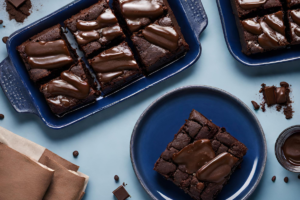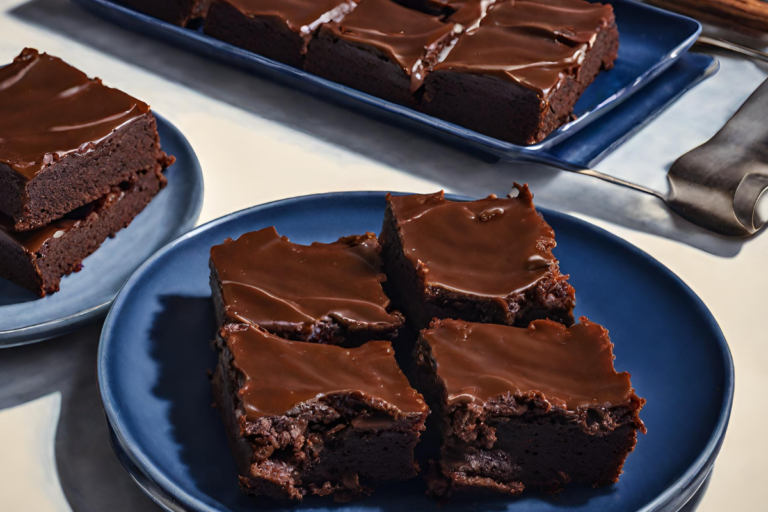What Defines Fudgy vs Cakey Brownies?
Key Characteristics of Fudgy Brownies
Fudgy brownies are the quintessential treat for those who dream of chocolate in its richest form. What’s their secret? It’s all in the ratios! These brownies boast a higher fat content, thanks to generous amounts of butter and chocolate. This composition results in a dense, moist texture that’s heart-stoppingly good.
Intrigued by how to achieve this at home? It’s simpler than you might think. Start with quality chocolate and don’t skimp on the butter. Mixing should be done gently; overzealous beating is a no-go here. The goal is to combine the ingredients just enough to blend them, keeping the air out and the fudginess in.
Recipes often call for minimal flour and might include an extra yolk or two, enhancing the velvety texture. Remember, pulling these brownies out of the oven at the right moment is crucial—slightly underbaked is the way to go. A glossy top and a gooey center are your cues to culinary success. Why not try making a batch using comprehensive brownie baking tips from Good Housekeeping for guaranteed results?
Characteristics of Cakey Brownies
On the flip side, cakey brownies offer a lighter, more structured experience. They resemble the beloved sponge cake, with a crumb that’s soft and airy. Achieving this delightful texture hinges on a different set of principles: more flour, and often, the inclusion of a leavening agent like baking powder.
For those who prefer their sweets to be less dense, cakey brownies are a match made in heaven. The trick lies in beating the batter enough to incorporate air but not so much that it becomes tough. Using a mixer at a moderate speed will introduce the right amount of air into your mix.
The correct baking pan and oven temperature also play pivotal roles. A shiny metal pan helps in achieving a lighter crust, while glass or dark-colored pans might cause the edges to overcook. Keep an eye on the baking time—these brownies should come out soft but fully set, with a slightly springy center.
Whether you lean towards the indulgence of fudgy brownies or the subtlety of cakey ones, understanding these nuances can elevate your baking game to new heights. Stay tuned for more insights and tips in the following sections to perfect your brownie-making skills!
Baking Science Behind Fudgy and Cakey Brownies
How Fat-to-Flour Ratios Affect Brownie Texture
Distinguishing the fudgy and cakey brownies through their ingredient ratios. The battle between fudgy and cakey brownies largely hinges on one critical element: the fat-to-flour ratio. Fudgy brownies revel in their high-fat content, predominantly from butter and chocolate, which ensures they’re rich and moist. They have significantly less flour, which prevents the formation of a cake-like structure and keeps the center dense and chocolatey.
Conversely, cakey brownies boast a higher flour content relative to fat. This not only provides a sturdier structure but also allows for the incorporation of air, particularly when leavening agents like baking powder are added. This combo results in a lighter, fluffier texture reminiscent of a classic cake. Just right for those who appreciate a less intense chocolate experience but still crave that sweet satisfaction.
Eggs: The Binding Decision
Eggs play a pivotal role in determining the texture of your brownies. In fudgy brownies, you might find recipes suggesting the addition of an extra yolk or two. Why? Because yolks are fat-rich, they add to the density and moistness of the brownie, enriching its decadent profile.
In cakey brownies, the complete eggs are used to their full potential to bind the ingredients while helping to leaven and aerate the mixture during baking. This process is vital for achieving that light and airy texture that makes cakey brownies so distinct.
Mixing Techniques: Stirred, Not Beaten
The method you use to combine your brownie ingredients can dramatically affect their texture. For fudgy brownies, the mantra is simple: stir gently and only until combined. Over-mixing here can introduce too much air, leading to a cakey texture—not what you want if you’re aiming for that gooey, chocolatey goodness.
On the other hand, cakey brownies benefit from a bit more vigorous mixing. Using an electric mixer to beat the batter not only incorporates air but also helps to develop the gluten in the flour slightly, which is essential for creating a cake-like structure.
Balancing these elements is key to mastering the art of brownie making. Whether you prefer the dense, rich allure of a fudgy brownie or the light, fluffy charm of a cakey brownie, understanding and applying these principles will help you bake your way to perfection. Don’t hesitate to experiment with different approaches, and remember, each batch is a step closer to finding your brownie bliss.

Baking Tips for Perfect Brownies
Tips for Fudgy Brownies
Achieving the ultimate fudgy brownie is a dream for many, and luckily, it’s quite attainable with the right approach. Here’s how to ensure your brownies are rich, moist, and irresistibly chocolatey:
- Quality Ingredients: Start with high-quality chocolate and real butter. The flavor of your brownies hinges significantly on the chocolate used, so opt for the best you can find.
- Gentle Mixing: Remember, the less you stir, the fudgier your brownies will be. Mix just until your ingredients are combined—this keeps the batter dense and helps maintain that moist, gooey texture.
- Avoid Overbaking: To preserve the soft, chocolatey center, pull your brownies out of the oven when they still look slightly underbaked. They will continue to cook slightly from the residual heat of the pan.
These tips are fundamental for creating that melt-in-your-mouth experience that fudgy brownie aficionados adore. For further guidance on selecting the right chocolate, refer to Epicurious for some rich chocolate recipes.
Tips for Cakey Brownies
For those who prefer their brownies with a lighter, more cake-like texture, here are some tips to achieve that perfect cakey consistency:
- Right Ratio of Ingredients: Ensure your recipe uses a higher proportion of flour and consider including a leavening agent like baking powder to help your brownies rise.
- Adequate Mixing: Unlike fudgy brownies, cakey ones benefit from a bit more air. Use an electric mixer to beat the batter just enough to incorporate air without overdoing it.
- Proper Baking Pan: Using the right pan can make a big difference. A light-colored metal pan is ideal as it reflects heat, allowing the brownies to bake evenly without over-browning.
Following these tips can help you achieve a fluffy texture and even crumb that make cakey brownies so delightful. Also, consider checking Food Network for essential baking techniques that can enhance your baking skills across all types of recipes.
Whether you’re a team fudgy or team cakey, mastering these baking tips will allow you to tailor your brownie batches to suit any preference or occasion. Keep these pointers in mind next time you’re in the kitchen for a guaranteed sweet success!
Mastering Brownie Variations and Flavors
Now that we’ve delved deep into the textures and baking tips for perfecting fudgy and cakey brownies, let’s explore the exciting world of brownie variations and flavor enhancements. This part of our guide will inspire you to take your basic brownie recipe to new heights with simple tweaks and creative additions.
Exploring Flavor Add-Ins
The versatility of brownies makes them a fantastic canvas for flavor experiments. Consider these popular add-ins to elevate your next batch:
- Nuts and Seeds: Walnuts, pecans, or almonds can add a delightful crunch to your brownies. For a nuttier flavor, toast the nuts lightly before mixing them into the batter.
- Chocolate Chips and Chunks: Mixing different types of chocolate can intensify the chocolate experience. Try combining semi-sweet chips with dark chocolate chunks for a rich, multi-dimensional flavor.
- Fruit and Berries: Swirl in raspberry jam or scatter fresh raspberries atop the batter before baking for a tart contrast to the sweet chocolate.
Creative Swirls and Toppings
Adding swirls of caramel or peanut butter not only enhances the flavor but also creates an appealing visual effect. Simply dollop your chosen addition over the brownie batter and use a knife to swirl it through before baking. Toppings like marshmallows or a sprinkle of sea salt can add texture and flavor.
Spices and Extracts
Incorporating spices such as cinnamon or a dash of chili powder can add warmth and depth to your brownies. Vanilla extract is a classic addition, but why not try almond or peppermint extract for a refreshing twist?
Special Diet Adaptations
For those catering to special diets, brownies can easily be made gluten-free by substituting traditional flour with almond or coconut flour. Vegan variations can substitute eggs and butter with suitable plant-based alternatives like flax eggs and coconut oil.
Experiment and Enjoy
The beauty of baking brownies lies in the freedom to experiment. Each ingredient you choose to add or substitute can transform the texture, taste, and overall experience of your brownies. So, don’t hesitate to try new combinations and discover what delights your palate the most.
By embracing these variations and exploring new flavors, you can keep your brownie baking exciting and fresh. Whether you’re preparing a batch for a special occasion or simply indulging in a baking day at home, these ideas will ensure your brownies are always a hit.
Conclusion and Additional Resources
As we wrap up our exploration of fudgy versus cakey brownies, it’s clear that the perfect brownie comes down to personal preference and mastering a few key baking techniques. Whether you crave the dense, rich texture of fudgy brownies or the lighter, fluffier feel of cakey brownies, understanding the science behind these treats and adjusting your baking methods accordingly can make all the difference.
Embracing Personal Preference
Brownie lovers around the world will agree: the best brownie is the one that perfectly suits your taste buds. Some might argue for the gooey, chocolate-laden delight of a fudgy brownie, while others might prefer the structured, cake-like texture of a cakey brownie. The beauty of baking is that you can tweak recipes to find your ideal balance of texture and flavor.
Further Reading and Resources
For those eager to dive deeper into the art of brownie baking or explore other culinary ventures, a myriad of resources is available. Websites like Epicurious offer a wealth of recipes and tips for chocolate lovers, while Food Network provides essential baking techniques that cater to both novice bakers and seasoned pastry chefs. Additionally, comprehensive guides from Good Housekeeping—available through their baking tips section—can help refine your skills and inspire new ideas in the kitchen.
Continued Exploration
The journey to the perfect batch of brownies doesn’t stop here. Experiment with different chocolates, adjust your ratios and play with mixing techniques. Each batch is an opportunity to perfect your approach or try something new. Remember, baking is as much a science as it is an art, and the real joy comes from the process as much as the delicious results.
In conclusion, whether you’re team fudgy or team cakey, the perfect brownie is within your reach. Embrace the tips and insights shared in this guide, and keep refining your skills. Happy baking!

Frequently Asked Questions
Why are my brownies too fudgy or too cakey?
If your brownies turned out too fudgy or too cakey, it’s likely an issue with the ingredient ratios or baking time. For brownies that are too fudgy, you might have added too much butter or chocolate, or perhaps they were underbaked. On the other hand, if they’re too cakey, there might have been an excess of flour or overmixing, which can introduce too much air and give them a lighter texture.
How can I tell when my brownies are perfectly baked?
The perfection of brownies can be tricky to gauge since the usual “clean toothpick” test might not apply, especially for fudgy brownies. A good rule of thumb is to check the edges—they should be visibly baked through and starting to pull away from the pan. The center should appear set but not dry; it will firm up as it cools. For fudgy brownies, a slight underbake is preferable, as they continue to cook with residual heat.
Can I make brownies healthier without compromising texture?
Absolutely! You can tweak your brownie recipe for a healthier version by substituting some ingredients. Consider using applesauce or mashed bananas to replace some of the butter or oil, which reduces fat but still keeps them moist. Whole wheat flour or almond flour can replace all-purpose flour for added fiber and nutrients. Just be mindful that these substitutions can slightly alter the texture, so it might take a few trials to get it right.
What’s the best way to cut brownies cleanly?
Cutting brownies cleanly is all about timing and the right tool. Allow your brownies to cool completely before cutting—this helps them set and makes them less crumbly. Using a sharp knife is crucial; heat the blade with hot water and wipe it dry between cuts for the cleanest edges. For very fudgy brownies, refrigerating before cutting can make this process even easier.
Can brownies be frozen for later use?
Yes, brownies are excellent for freezing and can be stored for up to 3 months. Make sure they’re completely cooled and cut them into pieces. Wrap each brownie individually in cling film and then place them in a zip-top freezer bag. When you’re ready to enjoy them, let them thaw at room temperature for a few hours or warm them up in the microwave for a quick treat.
Handling these common queries can enhance your baking experience, allowing you to adjust your approach based on the results you’re aiming for. Next, we’ll wrap up our comprehensive guide with final thoughts and additional resources. Stay tuned for more insights that will help you master the art of brownie making!

